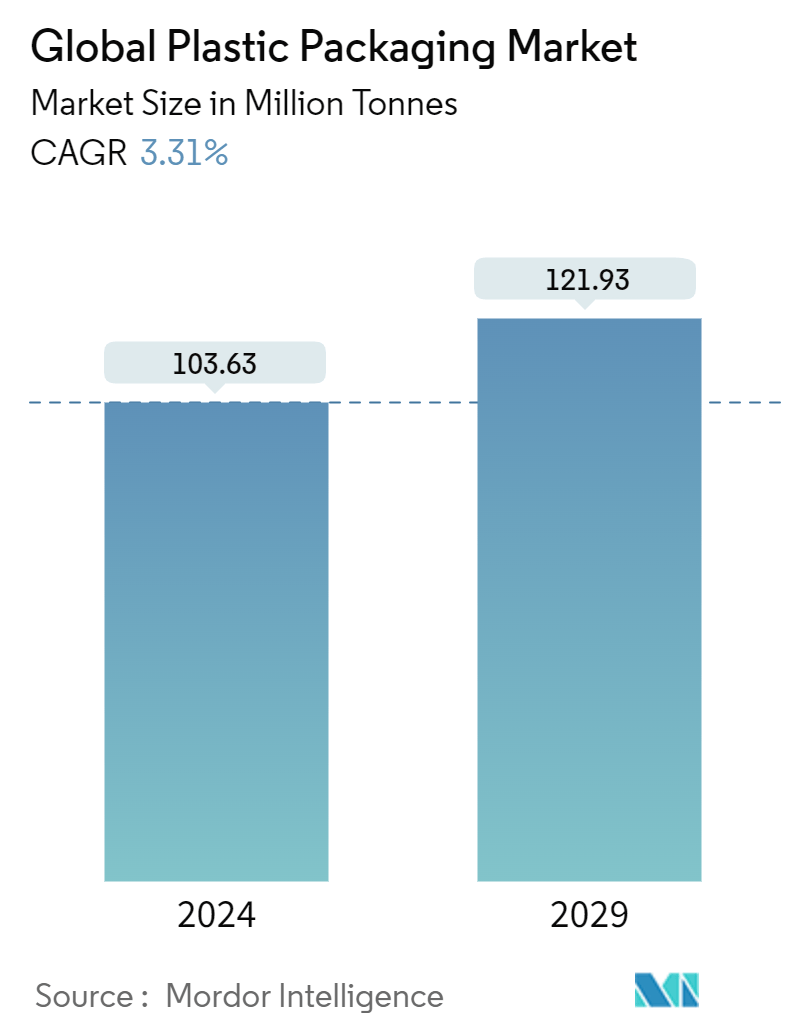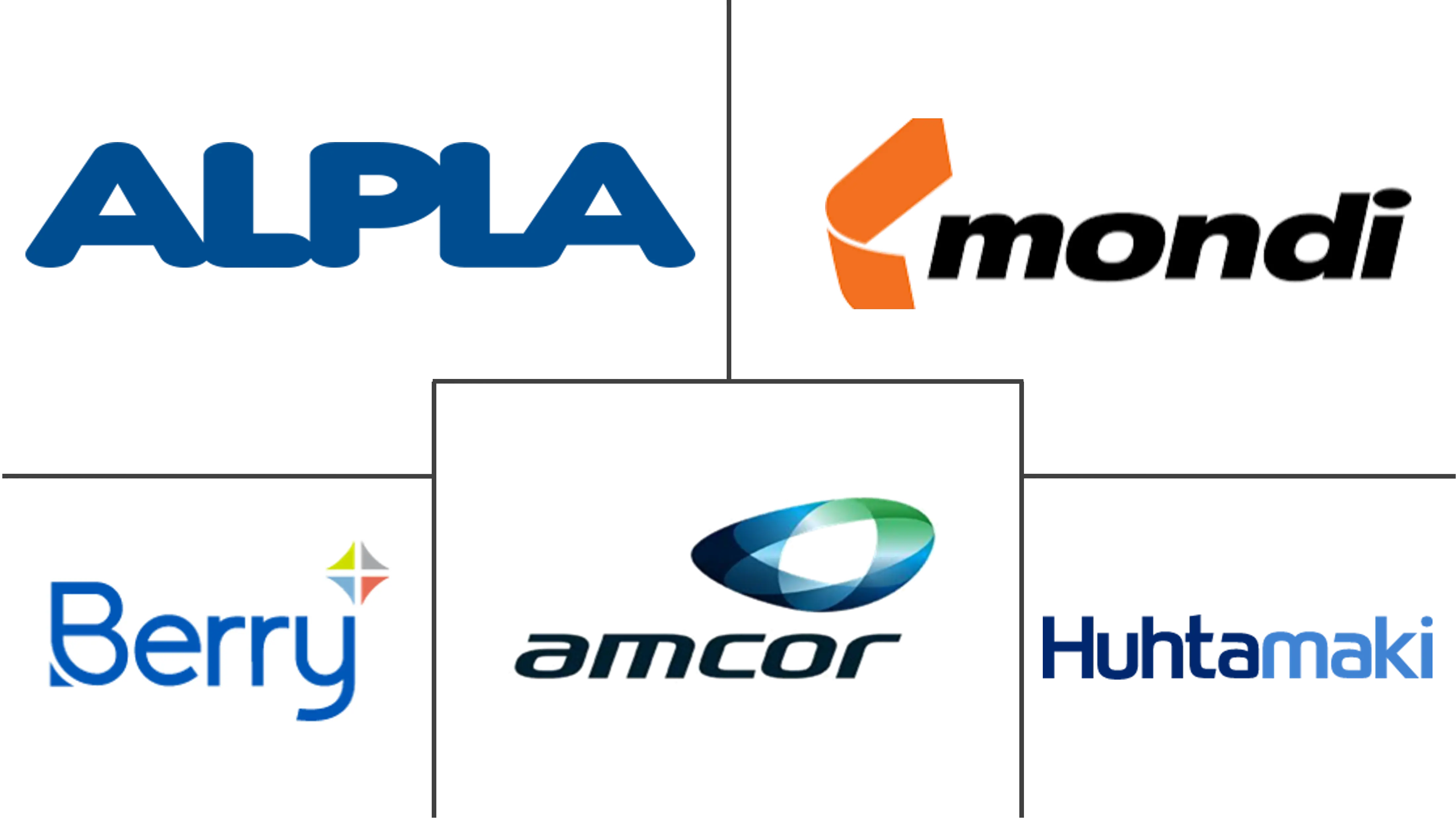Market Size of Global Plastic Packaging Industry

| Study Period | 2019 - 2029 |
| Base Year For Estimation | 2023 |
| CAGR (2024 - 2029) | 3.31 % |
| Fastest Growing Market | Asia-Pacific |
| Largest Market | Asia-Pacific |
| Market Concentration | Low |
Major Players
*Disclaimer: Major Players sorted in no particular order |
Plastic Packaging Market Analysis
The Global Plastic Packaging Market size is estimated at 103.63 Million tonnes in 2024, and is expected to reach 121.93 Million tonnes by 2029, growing at a CAGR of 3.31% during the forecast period (2024-2029).
- Plastic packaging has become a popular choice among consumers due to its durability, flexibility, and cost-effectiveness. This packaging form utilizes plastic films, containers, or other polymer-based materials to create a barrier against external elements, providing a versatile and lightweight solution for packaging a wide range of goods. Plastic containers are becoming essential in the beverage, food, cosmetics, and pharmaceutical industries.
- New filling technologies and the emergence of heat-resistant packaging material opened new possibilities and options in the market. While PET bottles are standard in multiple segments, cosmetics, sanitary products, and detergents are predominantly sold in polyethylene (PE) bottles.
- As per the OECD report, while over 120 countries have implemented bans and taxes on single-use plastics, these measures often fall short of effectively reducing overall pollution. Many regulations primarily target items like plastic bags, which constitute a small fraction of plastic waste, proving more successful in lowering littering than addressing the broader issue of plastic consumption. Furthermore, only a minority of countries have implemented landfill and incineration taxes that provide incentives for recycling, highlighting a global need for more comprehensive strategies to tackle plastic pollution.
- Several global companies increasingly recognize the urgency of recycling PET into food-grade products, such as beverage containers, which forms a major part of the current demand . This trend can drive the demand for PET across the world. For instance, the Coca-Cola Company intends to use 50% recycled PET in its containers by 2030. Also, Unilever is committed to making 100% of its plastic packaging reusable or recyclable by 2025.
- The e-commerce industry's rapid expansion is expected to create new opportunities for market expansion. To cut the cost of transportation, e-commerce enterprises favor lightweight and flexible packaging options. The industry is anticipated to flourish as more people shop online for fresh foods, FMCG products, electrical devices, and clothing every day.
- Additionally, more significant opportunities for plastic packaging are anticipated in the coming years due to the growing introduction of innovative packaging solutions, including active packaging, modified environment packaging, edible packaging, and bioplastic packaging. However, the industry's existence is expected to be challenged by growing sustainability awareness and a strict prohibition on single-use plastic to reduce plastic pollution.
Plastic Packaging Industry Segmentation
The plastic packaging market is segmented into rigid plastic packaging (by material type [polyethylene (PE), polyethylene terephthalate (PET), polypropylene (PP), polystyrene (PS) and expanded polystyrene (EPS), polyvinyl chloride (PVC), and other material types), product (bottles and jars, trays and containers, and other products], end-user industry [food, beverage, healthcare, cosmetics and personal care, and other end-user industries] and geography (North America {Material, End User- Industry, Countries[United States, Canada]}, Europe {Material, End User- Industry, Countries [United Kingdom, Germany, France, Italy, Spain, Rest of Europe]}, Asia-Pacific {Material, End User- Industry, Countries[China, India, Japan, Australia and New Zealand, Rest of Asia-Pacific]}, Latin America {Material, End User- Industry, Countries [Brazil, Argentina, Mexico, Rest of Latin America]}, and Middle East and Africa {Material, End User- Industry, Countries [United Arab Emirates, South Africa, Saudi Arabia, Egypt, Rest of Middle East and Africa]}). It is also segmented into flexible plastic packaging (by material type [polyethylene (PE), bi-orientated polypropylene (BOPP), cast polypropylene (CPP), polyvinyl chloride (PVC), ethylene vinyl alcohol (EVOH), and other material types], product type [pouches, bags, films and wraps, and other product types], end-user industry [food, beverage, cosmetics and personal care, healthcare, and other end-user industry] and geography (North America {Material, End User- Industry, Countries [United States, Canada]}, Europe {Material, End User- Industry, Countries[United Kingdom, Germany, France, Italy, Spain, Rest of Europe], Asia-Pacific {Material, End User- Industry, Countries[China, India, Japan, Australia and New Zealand, Rest of Asia-Pacific]}, Latin America {Material, End User- Industry, Countries [Brazil, Argentina, Mexico, Rest of Latin America]}, and Middle East and Africa{Material, End User- Industry, Countries[United Arab Emirates, South Africa, Saudi Arabia, Egypt, Rest of Middle East and Africa]}. The Industry size and market forecasts are provided in terms of volume (tonnes) for all the above-mentioned segments.
| RIGID PLASTIC PACKAGING | |||||||||||||||||||||||||||||||||||||||||||||||||||||
| |||||||||||||||||||||||||||||||||||||||||||||||||||||
| |||||||||||||||||||||||||||||||||||||||||||||||||||||
| |||||||||||||||||||||||||||||||||||||||||||||||||||||
|
| FLEXIBLE PLASTIC PACKAGING | ||||||||||||||||||||||||||||||||||||||||||||||||||
| ||||||||||||||||||||||||||||||||||||||||||||||||||
| ||||||||||||||||||||||||||||||||||||||||||||||||||
| ||||||||||||||||||||||||||||||||||||||||||||||||||
|
Global Plastic Packaging Market Size Summary
The global plastic packaging market is experiencing steady growth, driven by its widespread adoption across various industries such as food, beverages, cosmetics, and pharmaceuticals. The demand for plastic packaging is fueled by its durability, flexibility, and cost-effectiveness, making it a preferred choice for packaging solutions. Innovations in filling technologies and the development of heat-resistant materials are expanding the market's possibilities. Despite the environmental challenges posed by plastic waste, the industry is witnessing a push towards sustainability, with major companies like Coca-Cola and Unilever committing to increasing the use of recycled materials in their packaging. The rapid expansion of the e-commerce sector further propels the demand for lightweight and flexible packaging solutions, creating new opportunities for market growth.
In the Asia-Pacific region, particularly in China, the plastic packaging market is significantly influenced by rising consumer demand and increased consumption of packaged goods. The region's market growth is supported by the introduction of sustainable packaging solutions, such as recyclable and compostable materials, by key players like Essel Propack and PepsiCo. The market is highly competitive, with numerous players like Alpla Group, Amcor PLC, and Berry Global Inc. actively participating in the development of innovative and eco-friendly packaging solutions. The industry's focus on sustainability and recycling is evident in recent product launches, such as Mars China's mono-material flexible packaging and Berry Global's reusable bottles made from post-consumer recycled plastic. These developments highlight the industry's commitment to reducing plastic waste and promoting a circular economy.
Global Plastic Packaging Market Size - Table of Contents
-
1. MARKET INSIGHTS
-
1.1 Market Overview
-
1.2 Industry Attractiveness - Porter's Five Forces Analysis
-
1.2.1 Threat of New Entrants
-
1.2.2 Bargaining Power of Buyers/Consumers
-
1.2.3 Bargaining Power of Suppliers
-
1.2.4 Threat of Substitute Products
-
1.2.5 Intensity of Competitive Rivalry
-
-
1.3 Industry Value Chain Analysis
-
1.4 Market Dynamics
-
1.4.1 Market Drivers
-
1.4.1.1 Growing Geriatric Population and Prevalence of Diseases
-
1.4.1.2 Product Innovations such as Downsizing Coupled with Relatively Low Costs
-
-
1.4.2 Market Challenges
-
1.4.2.1 Dynamic Nature of Regulations and Inability to Support Heavy Goods
-
-
-
-
2. MARKET SEGMENTATION
-
2.1 RIGID PLASTIC PACKAGING
-
2.1.1 Material
-
2.1.1.1 Polyethylene (PE)
-
2.1.1.2 Polyethylene Terephthalate (PET)
-
2.1.1.3 Polypropylene (PP)
-
2.1.1.4 Polystyrene (PS) and Expanded Polystyrene (EPS)
-
2.1.1.5 Polyvinyl Chloride (PVC)
-
-
2.1.2 Product
-
2.1.2.1 Bottles and Jars
-
2.1.2.2 Trays and containers
-
-
2.1.3 End-user Industry
-
2.1.3.1 Food
-
2.1.3.2 Beverage
-
2.1.3.3 Healthcare
-
2.1.3.4 Cosmetics and Personal Care
-
-
2.1.4 Geography
-
2.1.4.1 North America
-
2.1.4.1.1 Material
-
2.1.4.1.2 End-user Industry
-
2.1.4.1.3 Country
-
2.1.4.1.3.1 United States
-
2.1.4.1.3.2 Canada
-
-
-
2.1.4.2 Europe
-
2.1.4.2.1 Material
-
2.1.4.2.2 End-user Industry
-
2.1.4.2.3 Country
-
2.1.4.2.3.1 United Kingdom
-
2.1.4.2.3.2 Germany
-
2.1.4.2.3.3 France
-
2.1.4.2.3.4 Italy
-
2.1.4.2.3.5 Spain
-
-
-
2.1.4.3 Asia
-
2.1.4.3.1 Material
-
2.1.4.3.2 End-user Industry
-
2.1.4.3.3 Country
-
2.1.4.3.3.1 China
-
2.1.4.3.3.2 India
-
2.1.4.3.3.3 Japan
-
2.1.4.3.3.4 Australia
-
2.1.4.3.3.5 South Korea
-
2.1.4.3.3.6 Indonesia
-
2.1.4.3.3.7 Australia and New Zealand
-
-
-
2.1.4.4 Latin America
-
2.1.4.4.1 Material
-
2.1.4.4.2 End-user Industry
-
2.1.4.4.3 Country
-
2.1.4.4.3.1 Brazil
-
2.1.4.4.3.2 Argentina
-
2.1.4.4.3.3 Mexico
-
-
-
2.1.4.5 Middle East and Africa
-
2.1.4.5.1 Material
-
2.1.4.5.2 End-user Industry
-
2.1.4.5.3 Country
-
2.1.4.5.3.1 United Arab Emirates (UAE)
-
2.1.4.5.3.2 Saudi Arabia
-
2.1.4.5.3.3 South Africa
-
2.1.4.5.3.4 Egypt
-
-
-
-
-
2.2 FLEXIBLE PLASTIC PACKAGING
-
2.2.1 Material Type
-
2.2.1.1 Polyethene (PE)
-
2.2.1.2 Bi-orientated Polypropylene (BOPP)
-
2.2.1.3 Cast Polypropylene (CPP)
-
2.2.1.4 Polyvinyl Chloride (PVC)
-
2.2.1.5 Ethylene Vinyl Alcohol (EVOH)
-
-
2.2.2 Product Type
-
2.2.2.1 Pouches
-
2.2.2.2 Bags
-
2.2.2.3 Films and Wraps
-
-
2.2.3 End-user Industry
-
2.2.3.1 Food
-
2.2.3.1.1 Baked Food
-
2.2.3.1.2 Snacked Food
-
2.2.3.1.3 Meat, Poultry and Sea Food
-
2.2.3.1.4 Candy/Confections
-
2.2.3.1.5 Pet Food
-
-
2.2.3.2 Beverage
-
2.2.3.3 Cosmetics and Personal Care
-
2.2.3.4 Healthcare
-
-
2.2.4 Geography
-
2.2.4.1 North America
-
2.2.4.1.1 Material Type
-
2.2.4.1.2 End-user Industry
-
2.2.4.1.3 Country
-
2.2.4.1.3.1 United States
-
2.2.4.1.3.2 Canada
-
-
-
2.2.4.2 Europe
-
2.2.4.2.1 Material Type
-
2.2.4.2.2 End-user Industry
-
2.2.4.2.3 Country
-
2.2.4.2.3.1 United Kingdom
-
2.2.4.2.3.2 Germany
-
2.2.4.2.3.3 France
-
2.2.4.2.3.4 Italy
-
2.2.4.2.3.5 Spain
-
-
-
2.2.4.3 Asia
-
2.2.4.3.1 Material Type
-
2.2.4.3.2 End-user Industry
-
2.2.4.3.3 Country
-
2.2.4.3.3.1 China
-
2.2.4.3.3.2 India
-
2.2.4.3.3.3 Japan
-
2.2.4.3.3.4 Australia and New Zealand
-
-
-
2.2.4.4 Latin America
-
2.2.4.4.1 Material Type
-
2.2.4.4.2 End-user Industry
-
2.2.4.4.3 Country
-
2.2.4.4.3.1 Brazil
-
2.2.4.4.3.2 Argentina
-
2.2.4.4.3.3 Mexico
-
-
-
2.2.4.5 Middle East and Africa
-
2.2.4.5.1 Material Type
-
2.2.4.5.2 End-user Industry
-
2.2.4.5.3 Country
-
2.2.4.5.3.1 United Arab Emirates (UAE)
-
2.2.4.5.3.2 South Africa
-
2.2.4.5.3.3 Saudi Arabia
-
2.2.4.5.3.4 Egypt
-
-
-
-
-
Global Plastic Packaging Market Size FAQs
How big is the Global Plastic Packaging Market?
The Global Plastic Packaging Market size is expected to reach 103.63 million tonnes in 2024 and grow at a CAGR of 3.31% to reach 121.93 million tonnes by 2029.
What is the current Global Plastic Packaging Market size?
In 2024, the Global Plastic Packaging Market size is expected to reach 103.63 million tonnes.

